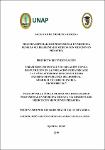Parasitosis intestinal y su relación con la desnutrición en la población pediátrica de 2 a 5 años atendidos por consultorio externo de pediatría del Hospital Regional de Loreto enero - diciembre 2017
Abstract
The World Health Organization (WHO) estimates that, in 2018, 25% of the world population was infected with parasites, specifically from the group belonging to helminths, mainly affecting underdeveloped countries. Therefore, I decided to analyze the relationship between intestinal parasitosis and malnutrition in the pediatric population aged 2 to 5 years attended by the outpatient clinic of the Regional Hospital of Loreto, Period January - December 2017. Carrying out a retrospective, descriptive and analytical study, of cases and controls; of the study population, patients aged 2 to 5 years with a diagnosis of intestinal parasitosis, a sample of 110 patients was taken for the case group and 110 for the control group who met the inclusion and exclusion criteria. The medical records were reviewed and selected randomly and the information was collected in a data sheet and the respective analysis was carried out with the SPSS 21.0 software, and descriptive statistics were applied, measures of central tendency, mean, median and in the dispersion measuresthis for the quantitative variables; in the statistical analysis using the chisquare. La Organización Mundial de la Salud (OMS) estima que, en el 2018, el 25% de la población mundial estaba infectada con parásitos, específicamente del grupo perteneciente a los helmintos, afectando sobre todo a países subdesarrollados. Por lo que decidí Analizar la relación entre parasitosis intestinal y la desnutrición en la población pediátrica de 2 a 5 años atendidos por consultorio externo del Hospital Regional de Loreto, Periodo Enero - Diciembre 2017.realizando un estudio de tipo, retrospectivo, descriptivo y analítico, de casos y controles; de la población de estudio, pacientes de 2 a 5 años con diagnóstico de parasitosis intestinal se tomó una muestra de 110 pacientes para el grupo caso y 110 para grupo control que cumplieron los criterios de inclusión y exclusión. Se revisó y selecciono las historias clínicas de forma aleatoria y se procedió a recolectar la información en una ficha de datos y se realizó el análisis respectivo con el software SPSS 21.0, y se aplicó estadística descriptiva, medidas de tendencia central, media, mediana y en las medidas de dispersión esto para la variables cuantitativas; en el análisis estadístico haciendo uso del chi-cuadrado.


